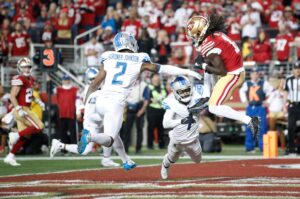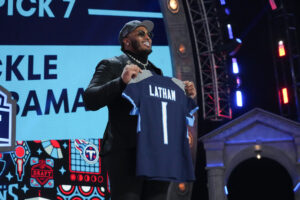The Green Bay Packers have been a pass-heavy offense for decades. A sound strategy, considering the Brett Favre era seamlessly gave way to that of current quarterback Aaron Rodgers. During this time, the team has enjoyed perennial success. It then stands to reason that the organization would invest heavily in the wide receiver position. However, the spending has reached a tipping point with the contract extension of Davante Adams.
In late December, Adams inked a new four-year deal worth $58 million with a majority of that money guaranteed. It was a necessary expenditure considering the demand Adams would garner on the open market. For the second consecutive year, the team finds itself atop the league in receiver expense by a wide margin. Packers receivers currently account for a robust 23.3 percent of next year’s salary. If Green Bay wants to be a balanced team, something’s got to give.
Green Bay Packers Wide Receiver Budget Is Unsustainable
With his new deal, Adams will have an average annual salary of $14.5 million, fourth highest in the NFL. That figure puts him on the same pay scale as elite players like A.J. Green and Julio Jones. By itself, that’s not a problem. The issue is next year’s cap hit for the rest of the Packers receivers. Randall Cobb ($12.7 million) and Jordy Nelson ($12.5 million) are both scheduled to be among the ten highest paid wideouts in 2018.
The average team salary allocation for receivers in the NFL is $17.6 million annually. Green Bay would more than double that next season with a staggering figure of $37.9 million. The next highest receiver budget for 2018 is the $28.2 million the Dallas Cowboys have on next year’s books.
Offensive production was down overall in 2017 due to Rodgers being out for a majority of the season. This makes evaluating the future worth of Nelson and Cobb exceedingly difficult. Nevertheless, looming financial commitments dictate a prompt decision. Adams had a productive season despite losing his franchise quarterback, hauling in 10 touchdowns for Green Bay. The rest of the receivers struggled to have any real impact week to week.
What Have You Done for Me Lately?
Nelson had a rough go of it with Brett Hundley at the helm. The veteran receiver finished the season with only 53 receptions for 482 yards on 88 targets. His six touchdown receptions all came from Rodgers in the first four games. Regarded as sure-handed, he caught a career-low 60.2 percent of intended targets. Blaming the circumstances is the easy assumption, but it could be the wrong one. Nelson’s catch rate has been steadily dropping each year since 2011 when he secured 70.8 percent of balls thrown his way.
When projecting future value, age must be considered as well. Nelson will be 33 years old next season, and the clear number two receiver on the team. It’s difficult to justify his 2018 price tag if he’s not even the primary pass catcher.
The Packers can choose to trade Nelson or outright release him prior to his final contract year, resulting in a dead cap hit of $2.3 million. This would save the team $10.25 million in salary next year. Another viable option is restructuring his current deal.
It’s possible Nelson wants to finish his career in Green Bay with the only quarterback he’s ever really known. Rodgers makes Nelson more productive because of his ability to throw him open. The two seem to share one mind at times, connecting on countless improvisational routes in the past.
Randall Cobb’s Future Is Uncertain
Even higher than Nelson on next year’s salary rankings is the seven-year veteran in Cobb. If Nelson is the number two receiver, then Cobb is third in the pecking order. Cobb had a spectacular 2014 season, putting up 1,287 yards and 12 touchdowns. He timed his breakout season perfectly and cashed in with a four-year, $39.9 million dollar deal. Since then, he’s been relatively mediocre.
The Packers organization hasn’t exactly gotten their money’s worth from their slot receiver in recent years. Over the past three seasons, Cobb has scored the same number of touchdowns (14) as Dallas Cowboys receiver Cole Beasley. Granted, Cobb has out-produced Beasley by a margin of 42 receptions and 409 yards in that time, but these things do not register on the scoreboard.
Comparisons in Context
Let’s look deeper at the significance of each player’s receptions. According to The Football Database, Cobb only had five more first down grabs than Beasley in this three-year span. Beasley is playing on a four-year, $13.6 million deal and he’s due to make $4.25 million in 2018. It hardly seems feasible to pay three times as much for similar output. Cobb is a solid player, but when Jones is set to make just $182,000 more than he does next season, it’s time to evaluate the situation.
In the event the Packers decide to part ways with Cobb, they would absorb a dead cap hit of $3.25 million, but save $9.5 million in cap space. A trade would be difficult, as teams would be reluctant to pick up the tab that comes with acquiring Cobb. Should Green Bay let their slot receiver go, the void is easy to fill. With the emergence of Aaron Jones and Jamaal Williams, they could afford to simply move former wideout Ty Montgomery back into the slot.
Montgomery made the move to running back out of necessity when Eddie Lacy went down with an ankle injury in 2016. The situation is very different now. The Packers drafted two capable backs since then who can handle the backfield responsibilities.
Big First Year for Brian Gutekunst
Brian Gutekunst‘s first season in charge is a critical one for the franchise. The team is transitioning to a new era. The Packers have the 14th pick in the upcoming draft which demands attention, pragmatism, and decisiveness. It’s nearly time to put a new deal together for Rodgers, the face of the franchise. Gutekunst must keep this in mind when making his current personnel decisions.
Clay Matthews could end up as a cap casualty as well. The veteran linebacker hasn’t produced double-digit sacks since 2014, yet he’s due to make $11.3 million next season alone. Releasing Matthews would result in no financial penalty whatsoever. Gutekunst also has new coordinators on both sides of the ball as well as multiple new position coaches. And oh, by the way, he’s expected to make a splash in free agency as well. The market figures to be cornerback-rich, a position the Packers desperately need to reinforce.
Dealing with the Packers receivers budget is undoubtedly high on the priority list. The newly minted general manager can choose to move money around or get it off the books entirely. Gutekunst has much to live up to, and it starts now with finances and logistics






